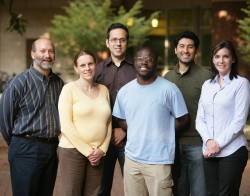
Imagine a picture of the sky so big that it would take 500,000 high-definition TVs to view it at full resolution.
The Sloan Digital Sky Survey-III collaboration, which includes Vanderbilt University, is making just such an image available to the public. The color image contains more than a trillion pixels and covers about one-third of the entire sky. The digital data included in the image was collected over the last decade by a dedicated telescope at the Apache Point Observatory in New Mexico.
SDSS astronomers have already used this information to discover nearly a half-billion astronomical objects, including asteroids, stars, galaxies and distant quasars. Now the scientists are making the data available to the public so that students, amateur astronomers and anyone else who is interested can analyze it and make additional discoveries.
“[rquote]This data release is part of SDSS’ efforts to encourage public involvement in science[/rquote],” says Assistant Professor of Astronomy and Physics Andreas Berlind, one of Vanderbilt’s participants. “The original Galaxy Zoo project, which harnessed the power of the Internet to allow people to use their computers to help classify individual galaxies, was created by SDSS and uses SDSS data. It was so successful that a number of similar sites have been set up.”
According to Berlind, the image being released is one part of the project that has documented the location, brightness, size and color of billions of celestial objects, including about 100 million galaxies. The second part of the project involves splitting the light down into different colors and analyzing the resulting spectra coming from individual objects. This allows SDSS astronomers to estimate each object’s distance so that they can construct a three-dimensional map of the visible universe. They have used this spectrographic technique to measure the distance of a million galaxies that lie within a billion light years from Earth. The SDSS telescope’s imaging system has been upgraded and is now being used to measure the distance of another 1.5 million galaxies that are much further away, at distances up to five billion light years.

Berlind and fellow astronomers Assistant Professor Kelly Holley-Bockelmann, Professor David Weintraub and Associate Professor Keivan Stassun are using the new data that the SDSS telescope is generating in their own research projects:
- Berlind is studying the distribution of the most distant galaxies in order to learn more about the process of galaxy evolution;
- Holley-Bockelmann is focusing on the structure and history of our own Milky Way galaxy; and
- Stassun and Weintraub are exploring methods to identify the types of stars most likely to possess exoplanets.
The sky survey collaboration includes the University of Arizona, the Brazilian Participation Group, Brookhaven National Laboratory, University of Cambridge, University of Florida, the French Participation Group, the German Participation Group, the Instituto de Astrofisica de Canarias, the Michigan State/Notre Dame/JINA Participation Group, Johns Hopkins University, Lawrence Berkeley National Laboratory, Max Planck Institute for Astrophysics, New Mexico State University, New York University, the Ohio State University, the Penn State University, University of Portsmouth, Princeton University, the Spanish Participation Group, University of Tokyo, the University of Utah, Vanderbilt University, University of Virginia, University of Washington, and Yale University.